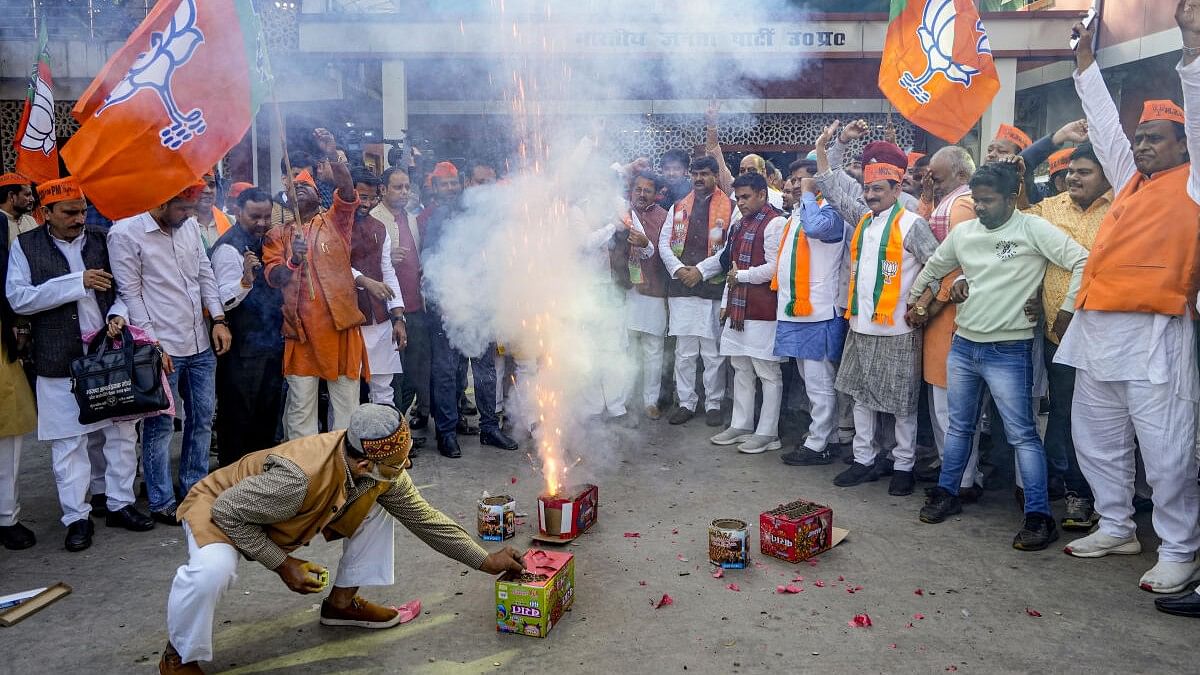
BJP workers and supporters celebrate the party's lead in Madhya Pradesh, Rajasthan and Chhattisgarh during counting of votes for the Assembly elections, in Lucknow.
Credit: PTI Photo
Going into the crucial round of Assembly elections, the Congress seemed to have the wind in its sails. In northern India, Chhattisgarh was supposed to be the done deal; Madhya Pradesh mostly so, riding an anti-incumbency sentiment; and Rajasthan a slim possibility, with a hung House a likely outcome. But a saffron deluge has all but drowned the party.
At the time of writing, the Bharatiya Janata Party (BJP) was on course for a massive majority in Madhya Pradesh and a similar show in Rajasthan, but the result in Chhattisgarh in its favour has been the most surprising of the outcomes.
In 2018, the Congress won 68 of the 90 seats in Chhattisgarh, racking up a 43 per cent vote share, as against the BJP’s 15 (down 34 from 2013) with a 33 per cent of the vote. Outgoing Chief Minister Bhupesh Baghel was supposed to ease his party home in a canter on the back of a record of good governance, welfare measures, and a reasonably clean record on the corruption front.
It hasn’t panned out that way, however. Scrambling home would have been met with disappointment, but at this moment even that isn’t on the cards, with the BJP crossing the 50 mark and the Congress languishing in the mid-30s. The BJP’s projected vote share around noon was pegged at 46 per cent compared to the Congress’s 42 per cent. These are trends for sure, but the psephological common sense is that from this kind of a position whichever party is ahead, goes on to entrench its position.
The question is what went wrong for the Congress in Chhattisgarh, in the context of the results in all the three north Indian states where it has been humbled despite an optimistic outlook going into the elections.
Let’s note the factors that seemed to have been working in its favour. It has been recognised that Baghel ran a tight ship. The administration was efficient and the benefits of the welfare schemes it had rolled out were reaching the beneficiaries. Unlike the situation in Rajasthan, where a good administrative record and excellent welfare packages were blighted by corruption on the ground, Baghel’s government was not widely seen to be corrupt. Yet, significantly, it was deserted most conspicuously by the tribal community in the key region of Bastar.
The obverse of this question is what suddenly went right for the BJP in Chhattisgarh and the two other states. It does appear that the blanket campaigning of Prime Minister Narendra Modi played a big role in turning the tide in the last-mile stretch. Not projecting a chief ministerial candidate in the three states gave him a clear field, taking the focus away from local issues and giving the election a plebiscitary dynamic.
The focus of the BJP campaign in Chhattisgarh was corruption, with communal rhetoric ramped up as always. The perception must have changed in the final days of campaigning. Using law-enforcement agencies to target people close to Baghel was an important element of the BJP strategy. Tellingly, the corruption charges against the BJP government didn’t get much traction in Madhya Pradesh.
In one election meeting after another, the BJP’s star campaigners kept majoritarian issues in the limelight. A salient fact is that the BJP doesn’t stop working when defeated. Aided by the Rashtriya Swayamsevak Sangh (RSS) network, solid political and organisational work, especially among the tribal communities, has paid off.
What does all this mean for the Lok Sabha next year? In 2019, the BJP won nine of the 11 seats from Chhattisgarh; 28 of 29 seats in Madhya Pradesh; and 24 of 25 in Rajasthan, with an ally winning the other one.
The Congress thus got three seats out of 65. It can’t do much worse. But it will have to realise that the BJP’s high success rates in elections of all sorts are achieved on the back of solid organisational work. Being washed out despite a positive campaign and high morale, points to the significant work that remains to be done in this arena.
Suhit K Sen is author of ‘The Paradox of Populism: The Indira Gandhi Years, 1966-1977’.
Disclaimer: The views expressed above are the author's own. They do not necessarily reflect the views of DH.